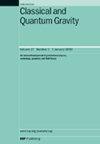LISA测试质量干涉仪中相位信号形式对倾斜-长度耦合噪声的影响
IF 3.7
3区 物理与天体物理
Q2 ASTRONOMY & ASTROPHYSICS
引用次数: 0
摘要
激光干涉仪空间天线(LISA)中的TTL耦合会产生假位移噪声,对引力波信号的测量有潜在的影响。在每一个测试质量干涉仪(tmi)中,不对准与航天器角抖动的耦合会在纵向路径长度信号中产生噪声。该信号来自象限光电探测器的干涉测量光束和本地参考光束的相位读出组合,但其计算存在多种公式。这种路径长度信号公式的选择会影响TTL耦合噪声。因此,我们模拟了两种路径长度候选信号,复和和平均相位,并在静态对准缺陷假设下评估了它们在LISA TMI中的性能。所有的模拟都使用三种不同的方法进行,并进行了交叉检查。我们发现,在所有三种方法中,在五个测试用例中的四个中,平均相位是具有相等或更小TTL耦合噪声的选择。最后,我们表明,在我们所有的测试用例中,无论选择哪种路径长度信号的公式,TMI中的非线性TTL贡献都可以忽略不计。本文章由计算机程序翻译,如有差异,请以英文原文为准。
Impact of phase signal formulations on tilt-to-length coupling noise in the LISA test mass interferometer
Tilt-to-length (TTL) coupling in the Laser Interferometer Space Antenna (LISA) can generate spurious displacement noise that potentially affects the measurement of gravitational wave signals. In each test mass interferometer (TMIs), the coupling of misalignments with spacecraft angular jitter produces noise in the longitudinal pathlength signal. This signal comes from the phase readout combinations of an interfering measurement beam and a local reference beam at a quadrant photodetector, but various formulations exist for its calculation. Selection of this pathlength signal formulation affects the TTL coupling noise. We therefore simulated two pathlength signal candidates, the complex sum and the averaged phase, and evaluated their performance in the LISA TMI under the assumption of static alignment imperfections. All simulations were performed using three different methods with cross-checked results. We find with all three methods that the averaged phase is the choice with equal or less TTL coupling noise in four out of the five test cases. Finally, we show that the non-linear TTL contributions in the TMI to be negligible in all our test-cases, no matter which formulation of pathlength signal is chosen.
求助全文
通过发布文献求助,成功后即可免费获取论文全文。
去求助
来源期刊

Classical and Quantum Gravity
物理-天文与天体物理
CiteScore
7.00
自引率
8.60%
发文量
301
审稿时长
2-4 weeks
期刊介绍:
Classical and Quantum Gravity is an established journal for physicists, mathematicians and cosmologists in the fields of gravitation and the theory of spacetime. The journal is now the acknowledged world leader in classical relativity and all areas of quantum gravity.
 求助内容:
求助内容: 应助结果提醒方式:
应助结果提醒方式:


